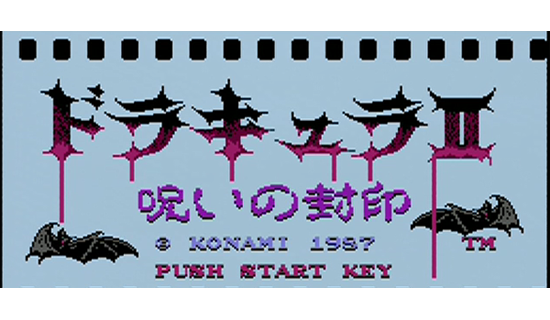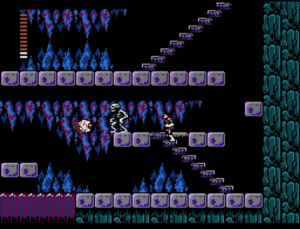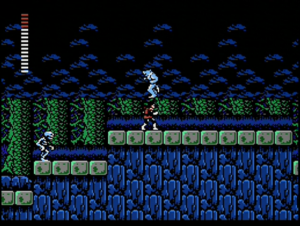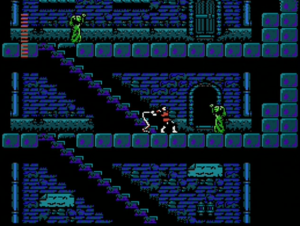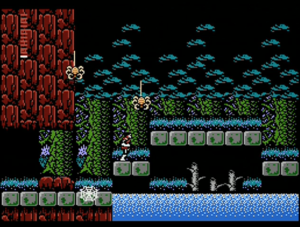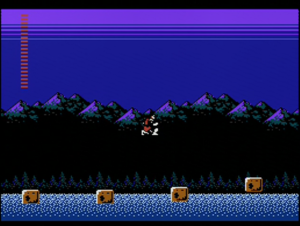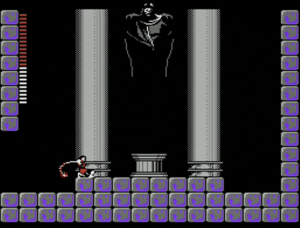Almost one year after the original Castlevania/Akumajou Dracula game, the same team is back to give us a direct sequel on the Famicom Disk System/NES. The nonsensical Japanese naming convention for the series begins here, since instead of calling this “Akumajou Dracula II”, Konami went with just “Dracula II”. The same basic Castlevania action is still here though, and it feels pretty much the same in your hands as before. But it’s 1987 now and Dragon Quest has been released in Japan, so what kind of action game would this be if it didn’t have RPG elements? Japanese ads referred to it as an “RPG Horror Action” game, and the timer and score that were present before are now gone. But even though the flow of the game is significantly different, the story is very much a direct continuation. And just like before, it’s only really explained well in the manual.
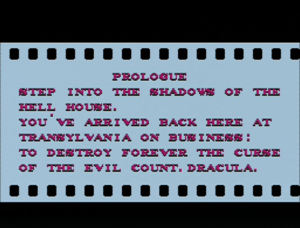
The following is my translation of the story from the Japanese manual (and yes, the last sentence also appears there, fully in English):
“Akumajou Dracula”…Seven years have passed since the final scene that we witnessed there. And once again we return to the Transylvanian countryside…
Our hero Simon Belmont has defeated Dracula and sent him back to his one hundred year slumber. However, he sacrificed much of himself during that battle. The wounds on his back have been eating further away at his body day by day, and he can feel his own death drawing nearer.
One morning, Simon went before the graves of the Belmont family on the Hill of Angels and looked back on his life. He then felt a presence behind him. When he turned around, he saw a lone woman in the morning mist.
The woman said to him: “Your life is being manipulated by an evil curse. You’re in grave danger. But if you have it within your heart to risk your life and stand up to that evil, God will grant you strength. The strength of the curse builds over time, and when it reaches its peak Dracula will be resurrected once again. There is but one way to permanently destroy his body: That is to begin his resurrection today, seven years to the day from when his body was first destroyed. He will appear when the five pieces of him are brought together. Find these pieces while the strength of the curse is still weak and burn them in his castle in order to seal him away. By doing this, you’ll finally be able to bring an end to the legend of Dracula. You’ll finally be free from this curse, and the wounds on your back will be able to heal. That is the only way to defeat Dracula forever.”
With those words, the woman disappeared into the mist. And our hero Simon Belmont began on his second journey with a new determination. This is the only way!
Fight, Simon!…
Please. Remember Bitter Memories in TRANSYLVANIA!
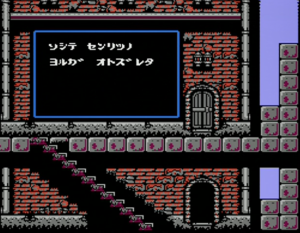
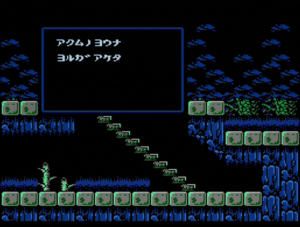
The most interesting new feature is that you’re no longer working your way through Dracula’s castle. Instead of a more traditional game level structure, Simon now roams throughout Transylvania, transitioning between various towns, forests, grave yards, castles and more. Each screen transition offers a potentially new experience, so you’re never quite sure what you’re going to see next. Various puzzles are scattered throughout the world, sometimes offering access to new equipment and sometimes gating progress to the next castle. If this sounds familiar, it might be because this is technically the birth of the “Metroidvania” direction that the Castlevania series would eventually go in. Metroid itself was just released for the Famicom Disk System earlier this very same month, so it isn’t very likely that Castlevania II took many queues from it at this point. As unlikely as it seems, both series reached this same point on their own. And while there isn’t any proof of it, later Metroidvania style games in the Castlevania series would have Zelda cited as a main influence. So the possibility of Zelda influence here isn’t out of the question.
The six castles (counting the final one, which is just a walk-up to the final battle with Dracula) are where you’ll be gathering whatever Dracula body part resides there, and are reminiscent of some of the interior levels from the original game. They’re also arguably the most bland parts of Castlevania II, with very little enemy and background variation, and rarely a boss to be found. When they do show up, none of the bosses are even remotely challenging by Castlevania standards, including Dracula himself.
Towns are where things get interesting. Their primary purpose is for you to exchange hearts (though they’re also still ammo for some sub-weapons) to purchase consumable items from townspeople, who are often hidden behind secret walls within houses (who knew that holy water could break down walls). Sometimes there will also be a church, which can be used to refill Simon’s health bar. The townspeople all have dialogue when you speak to them, and it will often be extremely vague and hard to understand clues as to how to progress. People usually chalk this up to bad translation, but even in Japanese the clues are difficult to make any sense of. Koji Igarashi (who would later take over as Director of the Castlevania series) stated in an interview that many of the townspeople purposefully lie to you. Along with some of the confrontational and just plan weird dialogue that you get in later towns (“Leave!”, “I want you”, etc.), it’s clear that some of these people are a bit unhinged after living in Transylvania for so long. All of the text being in katakana in the Japanese version doesn’t help things either. It’s much harder to parse out than I thought it would be.
If you’re interested in reading a little bit more about some comparisons between dialogue in the English and Japanese versions, Legends of Localization has done some fantastic articles on just that very topic: http://legendsoflocalization.com/digging-up-castlevania-iis-graveyard-duck/ http://legendsoflocalization.com/avgn/castlevania-ii/
This game is one of the first to feature a real day/night cycle, so at night all town inhabitants lock themselves in their homes, since monsters run about. This cycle applies everywhere but in the castles, and at night all enemies will be stronger but also give out more hearts when defeated. Apart from those things, it doesn’t really matter at any given time whether it’s day or night.
Since Castlevania is now part RPG, there’s an experience system now, and it’s a bit of an odd one. Each heart picked up from an enemy gives you a certain amount of experience points, depending on its size. As you gain levels though, you stop getting experience from hearts gained by weaker enemies, probably as an attempt to make sure that you’re spending most of your time fighting enemies appropriate to your level. This makes for some gaps where you’re not able to gain experience from anything that you’re fighting within a stretch of areas. On top of that, in order to get the best ending (even though there’s not much difference between the three possible endings) you have to complete the game in less than 8 in-game days. With leveling up to max level (which is 6), it seems like a challenge to pull that off unless you’re very familiar with the quickest paths through the game, and do most of your actual leveling in castles.
Each time you gain a level you’ll receive additional health and/or defense. Attack power is gained through whip upgrades. Instead of finding them in candles, they’re in various locations throughout the game. In fact Castlevania II really changes up how the sub-weapons are managed as well. You’re no longer restricted to having only one at a time, and you can now select from all your sub-weapons at any time via a menu. The sub-weapons include Holy Water, Sacred Flame, Dagger, Silver Knife, Golden Knife, Diamond, Laurels, and Garlic. Dracula’s various parts are equip-able alongside of a sub-weapon, and include : Rib (can be used as a shield when equipped), Heart (required to get the boatman to take you to a specific area in order to advance), Eyeball (can let you see things that would be otherwise invisible. Don’t get excited, it’s only books that “give you clues”), Nail (Allows your whip to break blocks that could otherwise be broken only with Holy Water), and Ring (is just required in order to finish the game, doesn’t do anything in particular).
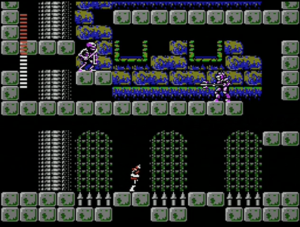
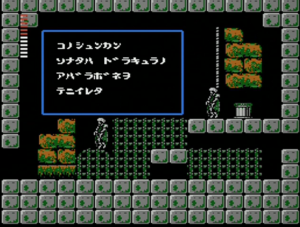
Since the music was such an important part of the first Castlevania, it needs to be mentioned here too. Kinuyo Yamashita (composer of the first game) has been replaced by Kenichi Matsubara (who would later go to to compose the Akumajou Dracula arcade game, also known as Haunted Castle). While Matsubara keeps the same baroque flavor to his compositions, I feel that they’re slightly weaker overall than Yamashita’s. There also seem to be less well remembered and reused tracks from Castlevania II, though it did bring us the famous Blood Tears. And though the original Castlevania didn’t take advantage of the Disk System’s additional sound channel with basic wave table support (this is why the Disk System and NES versions had an identical soundtrack), Castlevania II does. So while the Disk System and NES versions feature the same songs in the same places, they have slightly different sounds to them due to the hardware platforms. I don’t think that one is unequivocally better than the other, but there is a stronger case than usual to be made for the NES version being slightly better.
Apart from translations and music, the only other notable difference is the Famicom Disk System version has the ability to save upon death, similar to the FDS version of the first game. When you do this, you always start back at the first town but retain all levels, Dracula parts and sub-weapons (apart from laurels and garlic). The NES version on the other hand utilizes a frustrating password system, but at least they actually implemented one this time.
Instead of using puns based on famous monster movie titles and actors in the credits, this time we’re a little bit closer to crediting the actual people involved in the game’s development (the monsters don’t appear in the credits again), but they still have a strange twist. Before moving into the credits, the text “Programmed with the following characteristics” is displayed. We then see a “characteristic” displayed before the last name of each person in the credits: Invincibility Akamatsu, Permanence Iwasa, Philosophy Togakushi, etc. Konami itself is listed as Circumstance Konami. It should also be noted that though his first name is misspelled as “Simmon”, Simon Belmont’s last name is actually romanized as “Belmont” in the credits here instead of “Belmondo” in the first game. Why would it ever be “Belmondo”? In katakana the surname is in fact written ベルモンド (Berumondo) and not ベルモント (Berumonto). This makes me wonder how his last name was decided on as “Belmont” in the first place.
The best way to play this game is definitely with a walk-through. The idea that the townspeople give you difficult to figure out clues or just straight out lie to you is an interesting one, but it doesn’t mean that you can figure out what to do to do in order to progress (kneeling in front of lakes and cliffs with crystals equipped in order to get below water or have a tornado take you away, for example). The other big problem is that being good at this game is no longer a matter of mastering controls, learning enemy patterns, and figuring out what sub weapons are ideal for which boss. It’s learning bullshit like which blocks in a castle floor are fake, so that you don’t fall through them and have to redo sections of the level. Thankfully they’ll never lead you straight to death, but they were just a really bad design decision in the first place. Even outside the castles, Castlevania II has a much greater emphasis on precision platforming over combat.
This is just a very different sort of Castlevania game than its predecessor. And while I respect it for trying something different, I don’t think it works in this format just yet. It needs more refinement before it can be what everyone will eventually want out of a Metroidvania style game. The original Metroid has its problems, but I think it’s a much purer expression of this type of game-play since it’s more reliant on exploration and unlocking paths via upgrades and not obscure nonsense. It is an interesting piece of Castlevania history though, and is worth playing for anyone who’s interested in seeing the evolution of the series.
If you don’t fancy a disk or cartridge version of Castlevania II, it can be purchased on the Wii, Wii U or 3DS Virtual Consoles in any region. If you opt for an English version though, just know that you’ll be missing out on the superior title screen!
